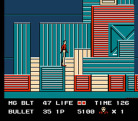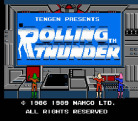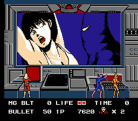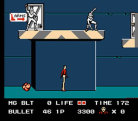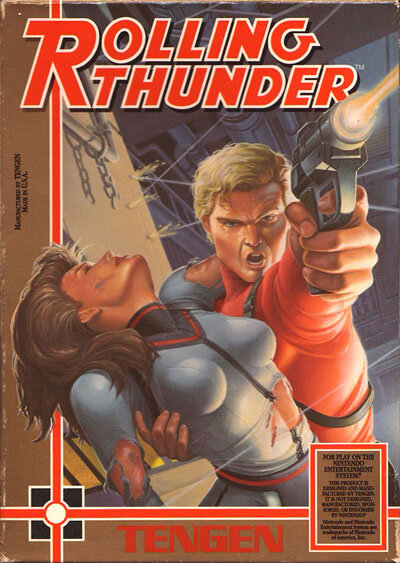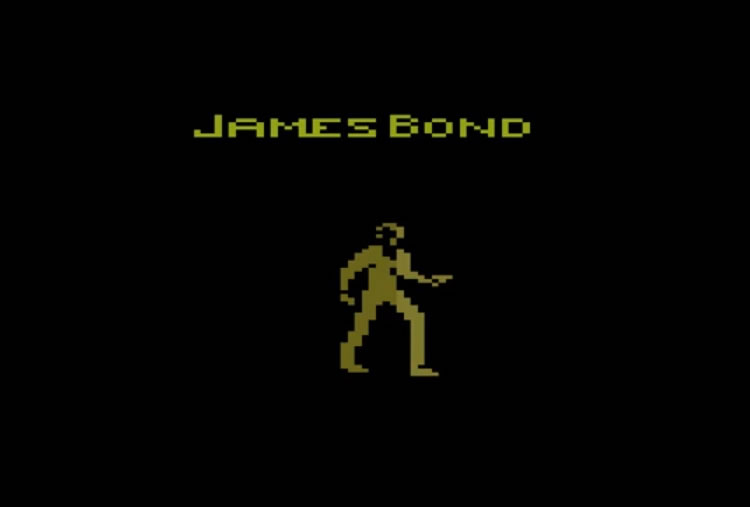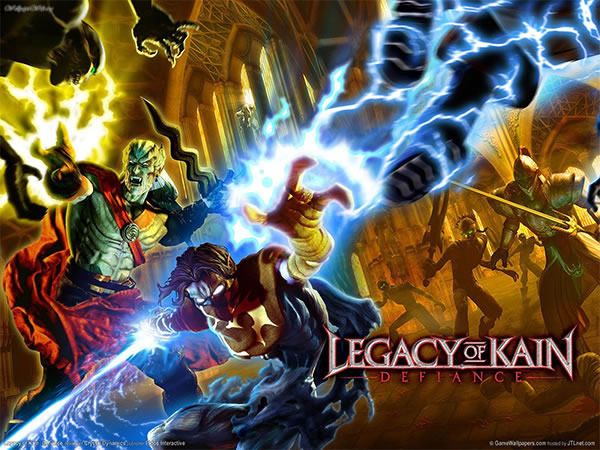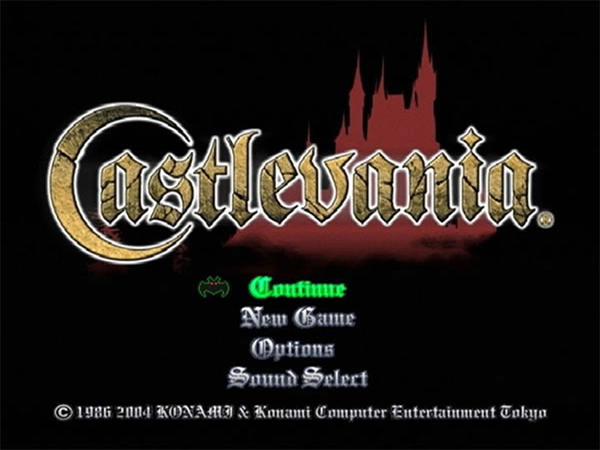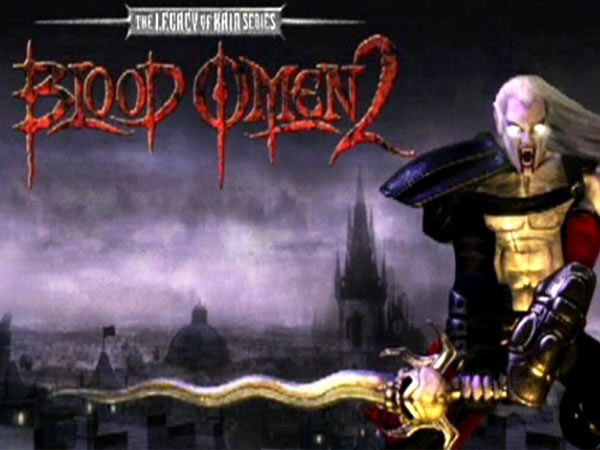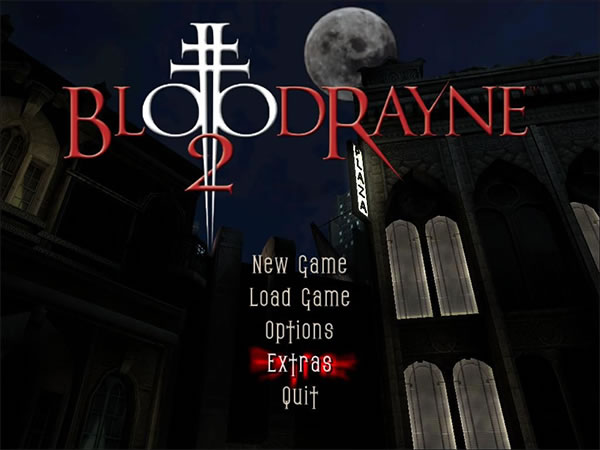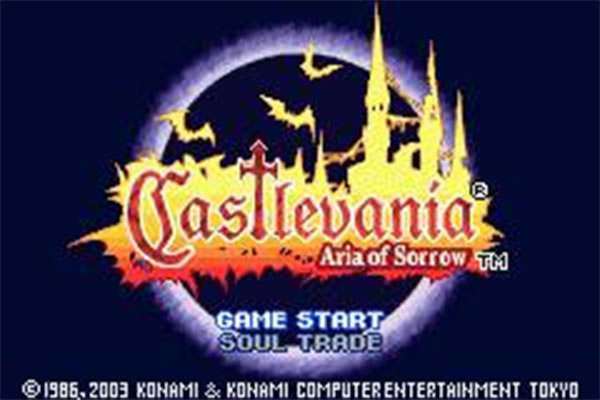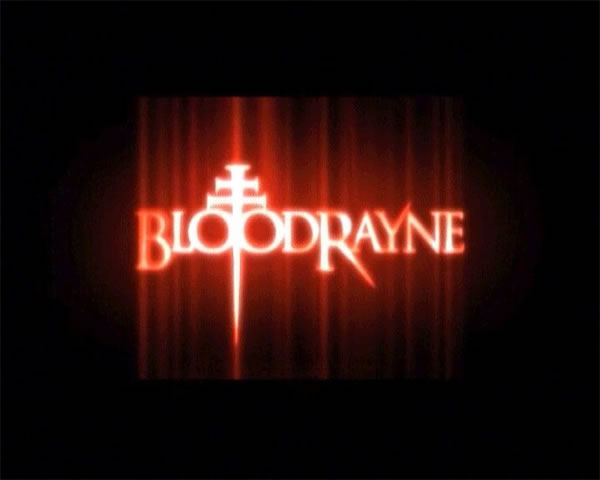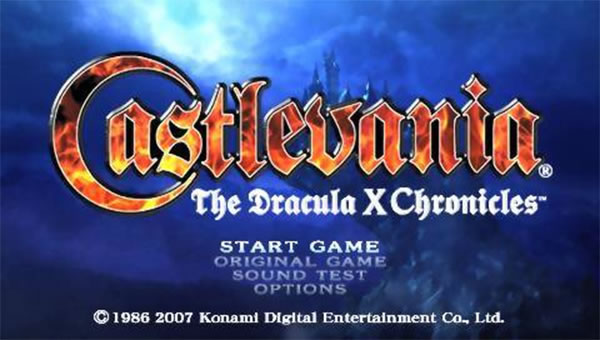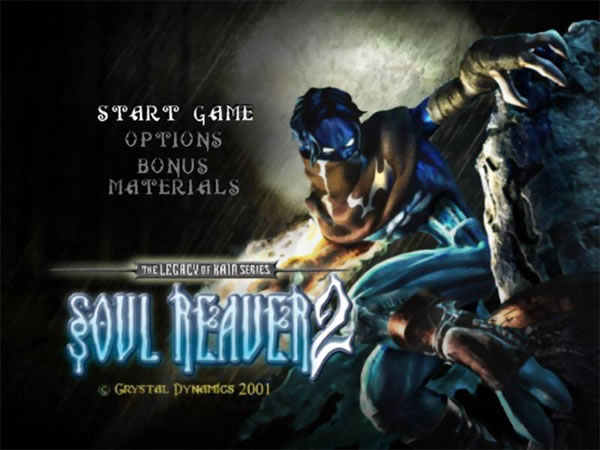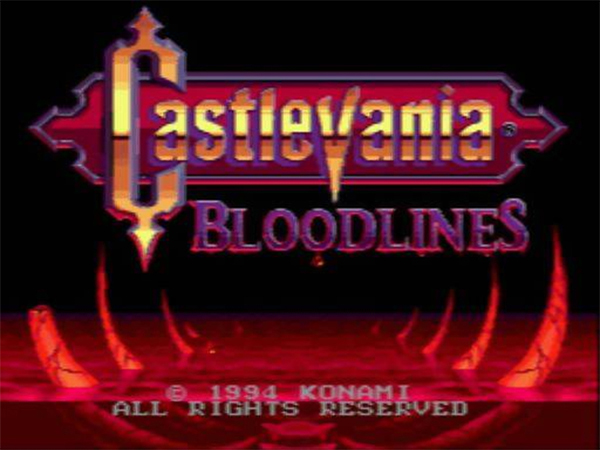- CLASSIC MAGAZINES
- REVIEW CREW
A show recapping what critics thought back
when classic games first came out! - NEXT GENERATION'S BEST & WORST
From the worst 1-star reviews to the best
5-stars can offer, this is Next Generation! - NINTENDO POWER (ARCHIVE)
Experience a variety of shows looking at the
often baffling history of Nintendo Power! - MAGAZINE RETROSPECTIVE
We're looking at the absolutely true history of
some of the most iconic game magazines ever! - SUPER PLAY'S TOP 600
The longest and most ambitious Super NES
countdown on the internet! - THEY SAID WHAT?
Debunking predictions and gossip found
in classic video game magazines! - NEXT GENERATION UNCOVERED
Cyril is back in this spin-off series, featuring the
cover critic review the art of Next Generation! - HARDCORE GAMER MAGAZING (PDF ISSUES)
Download all 36 issues of Hardcore Gamer
Magazine and relive the fun in PDF form!
- REVIEW CREW
- ELECTRONIC GAMING MONTHLY
- ELECTRONIC GAMING MONTHLY RANKS
From Mario to Sonic to Street Fighter, EGM
ranks classic game franchises and consoles! - ELECTRONIC GAMING MONTHLY BEST & WORST
Counting down EGM’s best and worst reviews
going year by year, from 1989 – 2009! - ELECTRONIC GAMING BEST & WORST AWARDS
11-part video series chronicling the ups and
downs of EGM’s Best & Worst Awards!
- ELECTRONIC GAMING MONTHLY RANKS
- GAME HISTORY
- GAME OVER: STORY BREAKDOWNS
Long-running series breaking down game
stories and analyzing their endings! - A BRIEF HISTORY OF GAMING w/ [NAME HERE]
Real history presented in a fun and pithy
format from a variety of game historians! - THE BLACK SHEEP
A series looking back at the black sheep
entries in popular game franchises! - INSTANT EXPERT
Everything you could possibly want to know
about a wide variety of gaming topics! - FREEZE FRAME
When something familiar happens in the games
industry, we're there to take a picture! - I'VE GOT YOUR NUMBER
Learn real video game history through a series
of number-themed episodes, starting at zero! - GREAT MOMENTS IN BAD ACTING
A joyous celebration of some of gaming's
absolute worst voice acting!
- GAME OVER: STORY BREAKDOWNS
- POPULAR SHOWS
- DG NEWS w/ LORNE RISELEY
Newsman Lorne Riseley hosts a regular
series looking at the hottest gaming news! - REVIEW REWIND
Cyril replays a game he reviewed 10+ years
ago to see if he got it right or wrong! - ON-RUNNING FEUDS
Defunct Games' longest-running show, with
editorials, observations and other fun oddities! - DEFUNCT GAMES QUIZ (ARCHIVE)
From online quizzes to game shows, we're
putting your video game knowledge to the test!- QUIZ: ONLINE PASS
Take a weekly quiz to see how well you know
the news and current gaming events! - QUIZ: KNOW THE GAME
One-on-one quiz show where contestants
find out if they actually know classic games! - QUIZ: THE LEADERBOARD
Can you guess the game based on the classic
review? Find out with The Leaderboard!
- QUIZ: ONLINE PASS
- DEFUNCT GAMES VS.
Cyril and the Defunct Games staff isn't afraid
to choose their favorite games and more! - CYRIL READS WORLDS OF POWER
Defunct Games recreates classic game
novelizations through the audio book format!
- DG NEWS w/ LORNE RISELEY
- COMEDY
- GAME EXPECTANCY
How long will your favorite hero live? We crunch
the numbers in this series about dying! - VIDEO GAME ADVICE
Famous game characters answer real personal
advice questions with a humorous slant! - FAKE GAMES: GUERILLA SCRAPBOOK
A long-running series about fake games and
the people who love them (covers included)! - WORST GAME EVER
A contest that attempts to create the worst
video game ever made, complete with covers! - LEVEL 1 STORIES
Literature based on the first stages of some
of your favorite classic video games! - THE COVER CRITIC
One of Defunct Games' earliest shows, Cover
Critic digs up some of the worst box art ever! - COMMERCIAL BREAK
Take a trip through some of the best and
worst video game advertisements of all time! - COMIC BOOK MODS
You've never seen comics like this before.
A curious mix of rewritten video game comics!
- GAME EXPECTANCY
- SERIES ARCHIVE
- NINTENDO SWITCH ONLINE ARCHIVE
A regularly-updated list of every Nintendo
Switch Online release, plus links to review! - PLAYSTATION PLUS CLASSIC ARCHIVE
A comprehensive list of every PlayStation
Plus classic release, including links! - RETRO-BIT PUBLISHING ARCHIVE
A regularly-updated list of every Retro-Bit
game released! - REVIEW MARATHONS w/ ADAM WALLACE
Join critic Adam Wallace as he takes us on a
classic review marathon with different themes!- DEFUNCT GAMES GOLF CLUB
Adam Wallace takes to the links to slice his way
through 72 classic golf game reviews! - 007 IN PIXELS
Adam Wallace takes on the world's greatest spy
as he reviews 15 weeks of James Bond games! - A SALUTE TO VAMPIRES
Adam Wallace is sinking his teeth into a series
covering Castlevania, BloodRayne and more! - CAPCOM'S CURSE
Adam Wallace is celebrating 13 days of Halloween
with a line-up of Capcom's scariest games! - THE FALL OF SUPERMAN
Adam Wallace is a man of steel for playing
some of the absolute worst Superman games! - THE 31 GAMES OF HALLOWEEN
Adam Wallace spends every day of October afraid
as he reviews some of the scariest games ever! - 12 WEEKS OF STAR TREK
Adam Wallace boldly goes where no critic has
gone before in this Star Trek marathon!
- DEFUNCT GAMES GOLF CLUB
- DAYS OF CHRISTMAS (ARCHIVE)
Annual holiday series with themed-episodes
that date all the way back to 2001!- 2015: 30 Ridiculous Retro Rumors
- 2014: 29 Magazines of Christmas
- 2013: 29 Questionable Power-Ups of Christmas
- 2012: 34 Theme Songs of Christmas
- 2011: 32 Game Endings of Christmas
- 2010: 31 Bonus Levels of Christmas
- 2009: 30 Genres of Christmas
- 2008: 29 Controls of Christmas
- 2007: 34 Cliches of Christmas
- 2006: 33 Consoles of Christmas
- 2005: 32 Articles of Christmas
- 2004: 31 Websites of Christmas
- 2003: 29 Issues of Christmas
- 2002: 28 Years of Christmas
- 2001: 33 Days of Christmas
- NINTENDO SWITCH ONLINE ARCHIVE
- REVIEW ARCHIVE
- FULL ARCHIVE
Rolling Thunder
Game critics have a funny way of wanting to put everything into easy to understand sub-genres. Your favorite Gradius sequel isn't just an action game; it's a shoot-em-up. Street Fighter II is a fighting game, while Final Fight is a brawler. And Secret of Mana is an action adventure game, not a turn-based role-playing game.
But not every game can be neatly explained in one of these descriptive sub-genres. What do you do with a game like Rolling Thunder? At first glance the game looks like nothing more than a side-scrolling shooter, nothing more than a slower paced Contra or Midnight Resistance. But look closer. Simply calling the game a shooter completely misses the best part of the game, a gimmick that was stolen by everybody from Sega to Capcom. Rolling Thunder isn't just a shooter; it's a shooter that allows you to literally leap from one floor to another to command two fronts in the on-going fight against crime. So what kind of game is Rolling Thunder? A 2D leap and gun shooter ... I guess.
Classifications aside, Rolling Thunder is a traditional side-scrolling action game where you walk (slowly) from left to right shooting anybody that gets in your way. The levels are split up into two different layers, one on top and one below. At any point you can jump up or down, allowing you to dodge enemy attacks and plan your attacks. This simple addition to the run and gun genre was enough to catch the eye of other game developers, as you see this gameplay nod used in both Shinobi and Code Name: Viper.
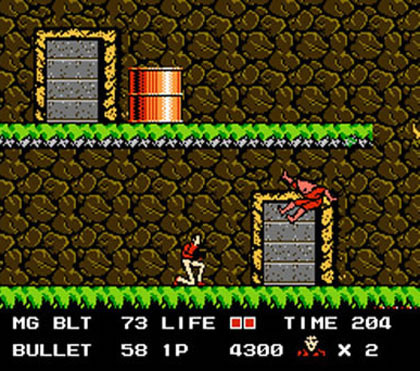
This Nintendo Entertainment System port comes to us from the good folks at Tengen, best known for their unlicensed 8-bit games and a bitchin' version of Tetris. Although the graphics have been stripped down to fit on the NES cartridge, the basic gameplay and level structure is there.
You play Albatross, a member of Interpol's "Rolling Thunder" espionage unit. Your job is to rescue a fellow agent, an inappropriately dressed woman by the name of Leila Blitz. She's being held in New York by a secret society known as Geldra. Of course, these story elements are only here to give you a reason to walk around and shoot hooded villains.
As I mentioned before, the game allows you to fight on two different levels at any given time. As you walk through the levels you will occasionally see levels above you; all you have to do is push up on the D-pad and the jump button and you'll find your super spy leaping 15 feet into the air and landing on the ground above. But don't get too comfortable on that second level, because all of the enemies you left below can jump too.
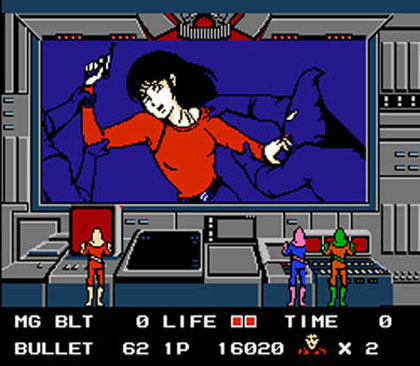
Outside of having a weird superhuman leaping ability, Albatross also knows how to open up and hide in doors. Scattered throughout each level are a series of doors; some that house enemies, some that have weapons and some that will give you extra time. It's important to spend some time exploring these doors as you go from area to area. Best of all, if you see an enemy coming and you don't have the time to get off a good shot, then you can hold the up button and remain in the door indefinitely.
Unfortunately these are the only two things that set this Rolling Thunder port apart from the other action games on the Nintendo Entertainment System. Outside of being able to leap high up into the air and hide in behind a door, there's really nothing special about this spy. He has limited moves, can't shoot in the air and has absolutely no control over how far he jumps. Couple this with the fact the NES port has sluggish control problems and you have a so-so port of an otherwise amazing (albeit dated) arcade game.
The nice thing about this Rolling Thunder port is that it doesn't skimp on the levels. Tengen comes to the plate with some twenty different levels. At first you'll be impressed at all of the different types of levels. You'll see indoor areas, warehouses, caves and more. However, as you keep playing through the game you'll realize that what's really happening is that you're visiting different locales over and over again. Thankfully these familiar levels now house brand new enemy types, including mutant monkey-things and cougars.
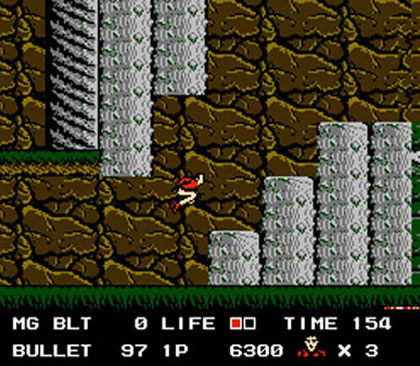
The graphics and sound are fine for a Nintendo Entertainment System game, but they certainly aren't as strong as their arcade counterpart. The good news is that you'll hardly notice the downsized graphics while you're shooting up bad guys and trying to avoid grenades. There's more than enough action here to make you forget all about the decrease in quality.
All in all, Rolling Thunder is a solid port of a great arcade game. While Tengen does manage to get the feel of the original game right, I can't help but notice all of the corners that were cut in the making of this 8-bit home game. Some of the cheap deaths and archaic design decisions ultimately bring the score down, but not enough to keep me from having a relatively good time playing through Rolling Thunder.
But not every game can be neatly explained in one of these descriptive sub-genres. What do you do with a game like Rolling Thunder? At first glance the game looks like nothing more than a side-scrolling shooter, nothing more than a slower paced Contra or Midnight Resistance. But look closer. Simply calling the game a shooter completely misses the best part of the game, a gimmick that was stolen by everybody from Sega to Capcom. Rolling Thunder isn't just a shooter; it's a shooter that allows you to literally leap from one floor to another to command two fronts in the on-going fight against crime. So what kind of game is Rolling Thunder? A 2D leap and gun shooter ... I guess.
Classifications aside, Rolling Thunder is a traditional side-scrolling action game where you walk (slowly) from left to right shooting anybody that gets in your way. The levels are split up into two different layers, one on top and one below. At any point you can jump up or down, allowing you to dodge enemy attacks and plan your attacks. This simple addition to the run and gun genre was enough to catch the eye of other game developers, as you see this gameplay nod used in both Shinobi and Code Name: Viper.

This Nintendo Entertainment System port comes to us from the good folks at Tengen, best known for their unlicensed 8-bit games and a bitchin' version of Tetris. Although the graphics have been stripped down to fit on the NES cartridge, the basic gameplay and level structure is there.
You play Albatross, a member of Interpol's "Rolling Thunder" espionage unit. Your job is to rescue a fellow agent, an inappropriately dressed woman by the name of Leila Blitz. She's being held in New York by a secret society known as Geldra. Of course, these story elements are only here to give you a reason to walk around and shoot hooded villains.
As I mentioned before, the game allows you to fight on two different levels at any given time. As you walk through the levels you will occasionally see levels above you; all you have to do is push up on the D-pad and the jump button and you'll find your super spy leaping 15 feet into the air and landing on the ground above. But don't get too comfortable on that second level, because all of the enemies you left below can jump too.

Outside of having a weird superhuman leaping ability, Albatross also knows how to open up and hide in doors. Scattered throughout each level are a series of doors; some that house enemies, some that have weapons and some that will give you extra time. It's important to spend some time exploring these doors as you go from area to area. Best of all, if you see an enemy coming and you don't have the time to get off a good shot, then you can hold the up button and remain in the door indefinitely.
Unfortunately these are the only two things that set this Rolling Thunder port apart from the other action games on the Nintendo Entertainment System. Outside of being able to leap high up into the air and hide in behind a door, there's really nothing special about this spy. He has limited moves, can't shoot in the air and has absolutely no control over how far he jumps. Couple this with the fact the NES port has sluggish control problems and you have a so-so port of an otherwise amazing (albeit dated) arcade game.
The nice thing about this Rolling Thunder port is that it doesn't skimp on the levels. Tengen comes to the plate with some twenty different levels. At first you'll be impressed at all of the different types of levels. You'll see indoor areas, warehouses, caves and more. However, as you keep playing through the game you'll realize that what's really happening is that you're visiting different locales over and over again. Thankfully these familiar levels now house brand new enemy types, including mutant monkey-things and cougars.

The graphics and sound are fine for a Nintendo Entertainment System game, but they certainly aren't as strong as their arcade counterpart. The good news is that you'll hardly notice the downsized graphics while you're shooting up bad guys and trying to avoid grenades. There's more than enough action here to make you forget all about the decrease in quality.
All in all, Rolling Thunder is a solid port of a great arcade game. While Tengen does manage to get the feel of the original game right, I can't help but notice all of the corners that were cut in the making of this 8-bit home game. Some of the cheap deaths and archaic design decisions ultimately bring the score down, but not enough to keep me from having a relatively good time playing through Rolling Thunder.
HOME |
CONTACT |
NOW HIRING |
WHAT IS DEFUNCT GAMES? |
NINTENDO SWITCH ONLINE |
RETRO-BIT PUBLISHING
Retro-Bit |
Switch Planet |
The Halcyon Show |
Same Name, Different Game |
Dragnix |
Press the Buttons
Game Zone Online | Hardcore Gamer | The Dreamcast Junkyard | Video Game Blogger
Dr Strife | Games For Lunch | Mondo Cool Cast | Boxed Pixels | Sega CD Universe | Gaming Trend
Game Zone Online | Hardcore Gamer | The Dreamcast Junkyard | Video Game Blogger
Dr Strife | Games For Lunch | Mondo Cool Cast | Boxed Pixels | Sega CD Universe | Gaming Trend
Copyright © 2001-2025 Defunct Games
All rights reserved. All trademarks are properties of their respective owners.
All rights reserved. All trademarks are properties of their respective owners.






